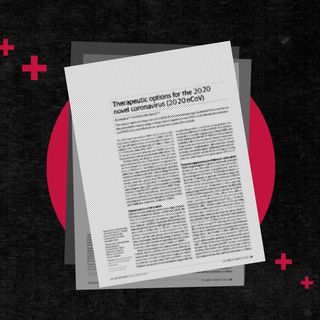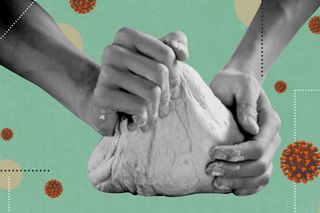
The Serendipity of Microbes: In Sourdough and In Pandemics
“Instead of falling asleep worrying about coronavirus counters and the economy, I now fall asleep envisioning the perfect boule.”

In the three weeks that we’ve been in lockdown, I have made a sourdough starter and three attempts at baking bread with it. Once I made my starter, which in itself is a week-long process of feeding, discarding, and checking on the stinky slop every day, with odd fondness, I proceeded to bake. By watching YouTube videos, reading countless blogs, and talking to friends who bake, I have been slowly initiated into the world of artisanal bread. As I went through the stages of pandemic fear, pandemic anger, pandemic grief, and slipped into pandemic acceptance, instead of falling asleep worrying about coronavirus counters and the economy, I now fall asleep envisioning the perfect boule. I worry about my starter not bubbling over, the dough over-proofing, and other bread-related things. I have mastered anxiety management by replacing worrying about something I have no control over, with something that I have control over.
Apparently a lot of people had the same idea, because there has been a shortage of flour in supermarkets world over and BBC Food has seen an 875% spike in traffic to its basic bread recipe. It says something about our intrinsic values of sustenance, what comforts us, and what we turn to during times of crisis when we all want to sit around warm ovens, baking. The history of bread, along with the history of pandemics is long and varied but they both pivot on microorganisms, which forms the crux of life itself.
According to Sylvia Neely’s A Concise History of the French Revolution, the average 18th-century worker spent half his daily wage on bread. But when the grain crops failed two years in a row, in 1788 and 1789, the price of bread shot up to 88% of his wages. On top of that, peasants resented the gabelle, a tax on salt that was unfairly applied to the poor. A plot was drawn up at Passy in 1789 to start a rebellion against the crown over the shortage of bread and shortly thereafter, the Bastille was stormed. As Turgot, an early economic adviser to Louis XVI, once advised the king, “Ne vous mêlez pas du pain” — Do not meddle with bread. Looking at our own history of the Dandi March, it is not hard to see why salt and flour trigger such high emotions, and therefore revolutions.
Related on The Swaddle:
In Quarantine, Capturing Our Chores On Social Media Gives Us a Sense of Community
Pandemics have also caused food shortages due to the disruptive nature of the disease. The 1918 flu caused widespread hunger in the world, and the UN has already warned of food shortages after the outbreak of the Covid19 pandemic. This explains perfectly our instinct to horde flour; on a gut-level, it means security. Over the past couple of weeks however, it isn’t history but biology that has been on my mind. Yeasts, like viruses, are ubiquitous and yet so under-appreciated. Perhaps the only people who understand yeast are bakers, winemakers, and brewers. Sourdough represents perhaps the most the most complex and personal interaction between biology and baker.
A sourdough starter is a symbiotic relationship between lactobacilli and yeast — in a healthy starter that ratio is 100:1. A landmark 1971 study of San Francisco sourdough by Sugihara and Kline identified a species of yeast called Candida milleri, which thrives with a bacteria that was dubbed Lactobacillus sanfranciscensis. C. milleri was found to be unable to digest maltose, one of the sugars derived from starch. However, the bacteria couldn’t get enough of it. And so a veritable feeding frenzy begins. The lactobacilli go to work first, breaking down the maltose and producing lactic and acetic acids, which drops the pH to around 3.8. The yeast that tolerates this acidic environment starts converting sugars into carbon dioxide and ethanol. The acidity also confers the dough preservative properties and gives sourdough its signature tang.
Water is the trigger that begins the digestion of carbohydrates in the flour. The proteins in the flour are glutenin and gliadin, collectively called gluten, and are inert, but once water is added and the starter is kneaded in, the party begins. These proteins begin to dance with each other and form hydrogen bonds and disulfide cross-links between their chains, with bubbles of carbon dioxide getting trapped in between the strands. This is what gives sourdough its classic open crumb. Eventually, a giant gluten network is formed throughout the dough as it visibly changes to something bouncy, stretchy, and alive, before your eyes.
It is mind-blowing to re-create this ancient experiment over and over in a modern kitchen. The realization that one unrecorded baker, the original maverick of yeast, discovered leavened bread through a fortuitous mistake 4000 years ago, speaks of the magic of chance and coincidences. If even a single incident in the sequence of events had changed, bread, as we know it, may not exist. History is peppered with such examples of serendipity, including the discovery of penicillin, another fungal derivative.
Bread at its most basic is flour, water, yeast, and salt. Within just these four ingredients, there are various permutations and combinations — the type of flour used, how much hydration you provide that flour, the type of yeast, how much salt, and when you add in the salt. Only if all these various steps go correctly, you get a palatable loaf. Genetic material is also just four base pairs, in various permutations and combinations, translated to create proteins. When replication occurs, the system aims for accuracy, but aberrations do occur. From a genetic standpoint, a mistake can be beneficial for a pathogen. For the baker, not so much.
Related on The Swaddle:
All of this strikes home that in order for something to thrive, conditions must be ideal. Consider this: there are around 1.6 million zoonotic viruses, out of this less than 200 are known to infect humans. Very few viruses actually cross the xenographic barrier between animals and humans. First, it has to have the pressure to mutate in a specific way in order to make the jump, which means the original host wasn’t doing a good enough job of supporting the virus. Second, the virus has to take the chance and make that jump to come in contact with a human. Third, it has to escape our incredibly adaptive immune system, which will launch an onslaught of attack to clear it out. Fourth, it has to fight its way through and find a matching cell with a matching receptor to which it can bind. Fifth, once it hijacks the cell and unpacks itself inside it, it must be able to replicate. Finally, once it replicates, it has to shed itself in large numbers in order to get transmitted and be truly successful. If it misses any of these steps, a virus is just an inert package of tangled proteins. Much like gluten without water.
When you begin a sourdough starter, you learn a lot about sterilizing the jar, using filtered water, and regulating temperature. What you are essentially doing is selecting the microorganisms you want, by creating an environment of support for them to thrive. Similar things happen to trigger pandemics. In the past two decades, only two viruses have breached the species barrier, capitalizing on an environmental hellscape of climate breakdown, habitat loss, and animal trafficking. It’s prescient just how much a nanoparticle changes life. But, ultimately, that’s the only thing that does.
Akhila Vijayaraghavan is a hydroponic farmer, powerlifter, diver, and writer. Trained as a molecular biologist at the University of Glasgow, she has worked in environmental strategy, advising companies on ESG and waste management. Now she runs an urban hydroponic farm focused on agritech innovations. Follow her on Twitter: @aksvi or Instagram: @thebokehchaser.
Related


Scientists Use IVF to Try to Save an Endangered Species of Toad
